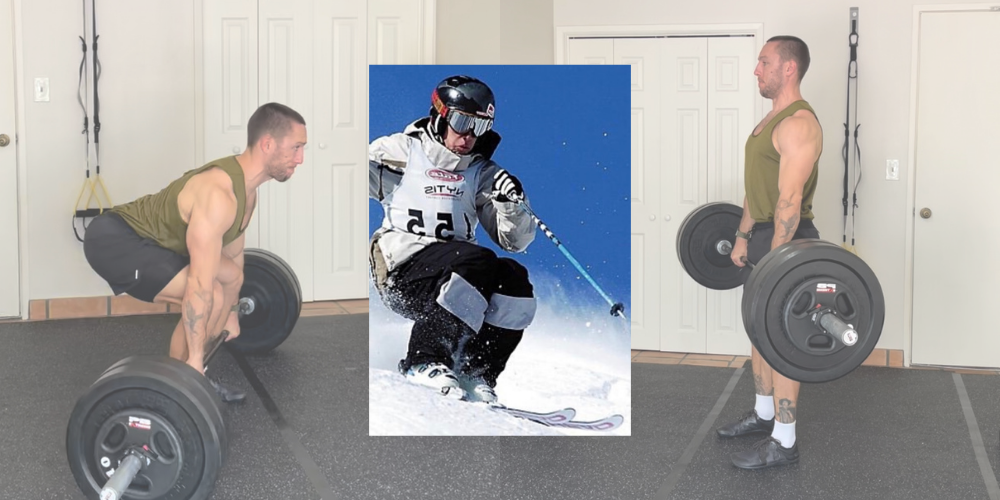
Should Skiers Deadlift?
Deadlifting is perhaps the most foundational strength exercises, and in my opinion, most essential baseline movement for human beings given our current state of affairs with office work, chairs, and a general proclivity for sitting whenever we get the chance.
There are two main concerns with sitting that should be established early to provide context for my argument; first, sitting for prolonged periods causes the hamstring muscles to shorten over time. Second, Sitting causes the hip flexors to tighten over time as they maintain a constantly flexed position while seated. Does it ever take you an extra second to fully stand up when you get out of your chair? That’s mostly because the posterior muscles (muscles behind you) are somewhat dormant and must elongate and contract to propel you into a standing position. But what does sitting and shortened muscle fibers have to do with deadlifting and skiing?
Skiing, mechanically, is a sport performed moving down a hill, at speed, with our weight disproportionately distributed in our quads. This creates quite an imbalance over time and a conceptual issue as one can easily imagine how vital their quad strength is to the sport simply because they feel those muscles with every turn. But what about the muscles behind our body? Are they important? Do they contribute in any way to a good ski turn?
The answer undoubtedly is yes! The posterior leg muscles such as the hamstring, gluteus medius, gluteus maximus, semimembranosus, as well as all posterior back muscles are not only essential to leg power and stability, they are the literal driving force behind good hip extension which is what manages the transition out of a ski turn’s apex.
To neglect training the posterior muscles in our body would be the biggest error any skier can make in preparation for the upcoming season, or maintenance of in-season strength. We as skiers must value our posterior muscles and train them appropriately to provide postural support and stability to our body as we barrel down the ski mountain.
The deadlift is the OG of posterior strength training exercises and, when performed with proper mechanics can be the difference between you aggressively standing up out of a tough situation, and double ejecting. Ultimately the deadlift, when performed at various tempos, both fast and slow, will provide the skier with muscular balance and efficiency to ski at their desired output while reducing the risk of injuries that result from muscular asymmetries between the front and back of the body. I like to perform deadlifts in two different capacities across three variations in equipment which can be found in many of the Ski System Training Programs.
The first capacity is controlled for both tempo and weight. Ideally these days are higher intensity (heavier), lower volume (less reps), and performed with either a trap bar or a conventional barbell. The trap bar will allow the skier to “cheat” slightly by involving more quad extension per rep. This results in more of a hybrid between the squat and deadlift while also providing a less demanding position for those that have limitations in shoulder range of motion. Essentially trap bar provides a better starting place and easier mechanics to begin. The conventional barbell will place more stress on thoracic (mid back) mobility and shoulder range of motion as the skier must retract (pull back) and depress (away from the ears) their scapula (shoulders) to achieve a proper starting position. You can additionally perform deadlifts with single dumbbells or kettlebells in the absence of the two listed pieces of equipment.
The second capacity is dynamic tempo. Dynamic means that the reps are going to be performed with a speed element. This means that once engaged, the skier will attempt to quickly drive into the floor propelling the weight off the ground until they are able to lock out. This contrast of controlled sets and dynamic work best prepares the skier for on-snow demands because ultimately skiing is a blend of both controlled and dynamic movements in and of itself.
When you ski, your hips must explode forward in some settings such as take-offs, recovering landings, and cliff drops (eccentric absorption). Conversely these posterior muscles must control the constant tension relationship between flexed and extended hips which places a unique demand on the quads and glutes synergistically to maintain our position.
I have spoken at length in previous blog posts about sets and rep schemes that you could apply to these variations in exercise type and force production. You can read those here and apply what works best for you in your current stage of the ski season.
As always, if you have questions, comments, or concerns, don’t hesitate to reach out to me directly on Instagram. I’m always happy to help
- Abe